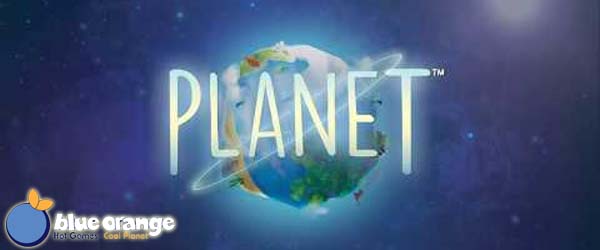
I think I'm becoming a fan of Blue Orange's line of family-friendly games. I bought Photosynthesis for my daughter several years back, and it has proven to be a hit with many of my adult friends for its fun and simple gameplay, and its lovely aesthetics! We've since bought a couple more of Blue Orange's games in the hopes of finding similarly fun and educational games that players young and old can enjoy. One such game is Planet, which is much simpler and quicker to play than Photosynthesis, but doesn't quite live up to Photosynthesis' production quality and educational value.
The core premise of Planet is that each player receives a magnetic dodecahedron that represents their barren "planet core". Each round, players select one of five possible "continents" to place on one of the surfaces of their "planet". Each continent tile is divided up into 5 parts, each with a terrain, and every continent tile has at least 2 different types of terrain on the tile.
Starting with the third round, randomly-drawn animal cards will be given to the player who has the planet that best meets each card's animal's respective habitat requirements, and each animal is worth points at the end of the game. In addition, each player is given a secret objective card that provides them bonus points at the end for covering as much of their planet as possible with a specific type of terrain.
Terrain types include green forests and jungles, brown mountains, yellow deserts, white ice, and blue ocean. Each animal has a preference for one specific type of terrain, as well as a secondary preference for adjacent terrain. By arranging your continent tiles on your planet in specific and varied configurations, your planet can hopefully attract the most animals.
Each player starts with a blank dodecahedron "planet", and builds a life-sustaining world continent by continent.
Abstract edutainment
Planet is an "edutainment" product that seems intended to teach children a little bit about animal habitats, how the relationships between different ecosystems drive animal evolution, and how biodiversity creates a healthier planet. Unfortunately, the game might be a bit too abstract in its educational endeavors, especially for a game intended for children under 12 years old.
There are a handful of animals that I don't recognize.
It would be nice if the game taught me about them.
The biggest failing (and missed opportunity) in the game, in my opinion, is that the animal cards lack any information about the animals themselves. Each card has a picture of the animal, and a graphic representing its preferred terrain types, as well as a colored border representing the animal's natural habitat. That's it. The cards don't even have the name of the animal printed on them. At bare minimum, these cards really should have had the name of each animal (and maybe also its scientific nomenclature as an added bonus for older players). As an adult, I recognize most of the animals by their picture, but there are a handful that I don't recognize. I'm guessing that a lot of young kids also have no clue what many of these animals are.
Had I designed the game, I also would have tried to print one or more little factoid(s) about each animal on their cards. Since the game puts a focus on the habitats of each animal, I think the factoids should probably emphasize the animal's niche within that particular habitat -- where it lies on the food chain, how it promotes the growth or health of the rest of its ecosystem, that sort of thing. But nope. We get nothing but a picture and the bare essentials of gameplay requirements.
For such a short, simple game, there's not a whole lot going on in terms of strategy, so it's a real missed opportunity that the game doesn't play up its educational elements more strongly.
That being said, the artwork on the cards is all very pretty. The animal images clearly depict the animal and a backdrop of its natural habitat, and a lot of them are really cute. The colors that represent each terrain type are vibrant and distinct, so that there should be no confusion about which terrain is which (barring extenuating circumstances like major color-blindness).
[More]